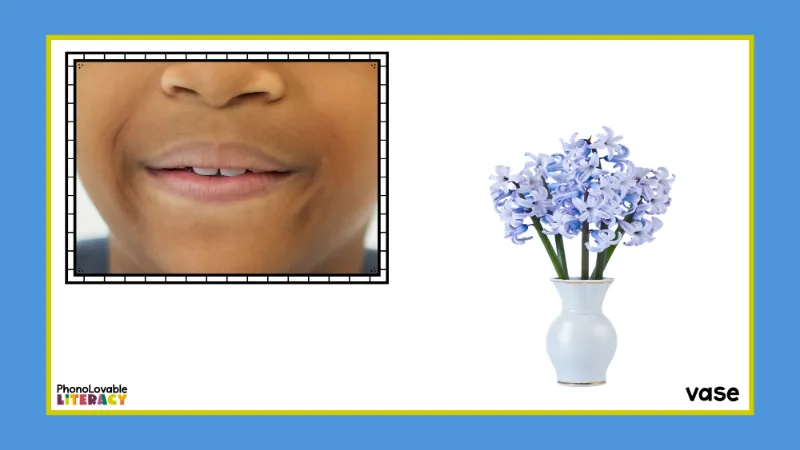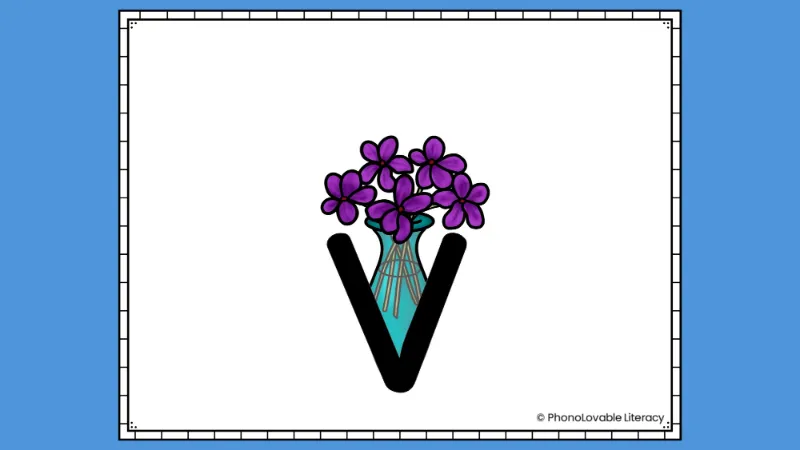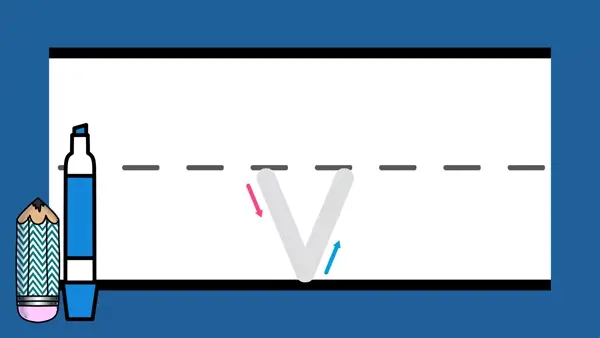Are you in need of a research-based routine for teaching the letter sound v to preschool or kindergarten children?
Do you get the feeling that there could be a better way to introduce letter sounds, something more effective and engaging than what you find in your current curriculum?
If so, I’d love to share a simple, effective, and enjoyable routine below. It’s based on solid reading research and something I’ve been using for years with amazing results!
You may be familiar with programs that show the printed letter v with a keyword picture under the letter and saying something like this:
“This is the letter v. V says /v/, as in vase. Repeat after me. V, vase, /v/.”
When I taught this way, most students eventually caught on. But there were too many kids, especially when I started teaching children at risk for reading struggles, who took so long to master and RETAIN letter sounds, that I wondered if there was a better way.
And there was! After years of diving into research studies and professional books, as well as signing up for every structured literacy training I could attend, I began making changes to my instructional routine of teaching letter sounds and have seen impressive improvement.
Below you’ll find a short explanation of the steps I follow and why they’re effective. I hope you’ll find something new to try with your own students. I’ll be cheering for you all!
Routine for Introducing the Letter V and Its Sound
You can watch this video to get an idea of the entire routine. You may also play it for your students!
Start with speech.
Why?
Children have a natural ability to process spoken language, so this is the most meaningful place to begin instruction. Focusing on the sound before introducing the letter that corresponds to that sound makes the most sense and gives students the greatest chance of success.


How?
Tell students that you are going to say a few words and their job is to listen carefully and repeat what they hear. You can also vary your voice for each word, just for fun. Say 3-6 words that begin with the letter v, such as vacation, van, and vase. Ask students to repeat each word (while you show images of the words if you can). Tell children that all of these words begin with the sound /v/.
Draw attention to your mouth when you make the /v/ sound.
Why?
Helping students SEE and FEEL what happens when we make a certain sound helps add more meaningful associations between letters and sounds and makes an abstract concept more concrete.


How?
To make this sound, you need to bite down on your bottom lip. Model this for your students and/or show a sound articulation card (“mouth pic”) such as the one above.
I tell my students to make it “buzzy” or “tickly”, to distinguish it from the /f/ sound (which is unvoiced). The sounds for /v/ and /f/ are produced the same way, therefore the mouth pics will look the same. That’s why it’s important for students to feel and hear the difference.
The /v/ sound is voiced and the /f/ sound is unvoiced. I model putting my hand to my throat to feel the /v/ “buzz” and then I cover my ears to hear the noise better. Contrast this to the quiet /f/ sound. Then ask students to try it out for themselves a few times.
Introduce the printed letter with an EMBEDDED mnemonic.
Why?
Research going back decades revealed that using embedded images, keyword pictures displayed within the letter as opposed to separate from the letter, resulted in students improving both the acquisition AND retention of letter-sound correspondences. In fact, it was more effective and efficient than the other methods studied, such as using a keyword picture next to the letter, or using just a keyword for each letter (no pictures).
What you’ll find in many phonics programs today are keyword pictures next to the letters, unfortunately, but embedded letters have been making a comeback in the past few years!


How?
Here is where you’ll first show your students the actual letter. But not just a plain letter, an embedded letter. The image of a keyword such as a vase embedded in the letter v helps solidify the connection between letter and sound. As pictured above, the shape of the vase full of violets corresponding to the shape of the lowercase letter v will serve as a reminder of the letter-sound relationship.
Model and practice how to write the letter.
Why?
Reading and writing are interrelated skills, and they should be taught together. Besides guessing at words, I’d say the second most common habit I see young students develop is inefficient letter formation. For the past few years, I’ve made it a point to prioritize letter formation as early as possible to prevent bad habits from forming. We teach phonemes and graphemes together so that students may not only read new words but learn to write them as well.


How?
I find most letter formation scripts in teacher’s guides to be unnecessarily wordy. I like to keep my language simple so students are more likely to memorize it. You may have different wording from a program you’ve used, or you may wish to change up how you say this, but here’s what I say as I model how to write the lowercase letter v:
“Start at the middle line. Little slant down. Little slant up.” I model with my hand in the air and/or show an animated slide on my computer (in small group) or smart TV (in whole group). Ask students to follow along with their fingers in the air. If children are seated at desks, ask them to finger-write the letter v on the desk.
I usually have students practice without a writing utensil a few times before I ask them to write with a dry-erase marker or pencil. This is just so I can make sure they’ve got the movements down or at least the letter-formation language before they put it on paper.
Research-Aligned Alphabet Resources
Need easy-to-use resources to implement the steps above?
Here are my recommendations for introducing the letter sound v and other letters to your preschool or kindergarten students:
Initial Sound Slides: These no-prep slides introduce each letter sound in the most effective and efficient way. With each click, you will show images of interesting photographs containing the beginning sound, a photo of a child making the sound along with a keyword image, the letter with an embedded mnemonic image, and lastly, an animated letter formation slide (one for uppercase and one for lowercase letters).
Mnemonic Alphabet Articulation Mouth Cards | Alphabet Posters with Real Pictures: If you prefer a paper option or don’t have access to digital resources, you may like these printable, 1-page posters of mouth pics along with the embedded mnemonic letters. It’s also a nice way to display the alphabet if you have classroom wall space.
Alphabet Picture Cards with Embedded Mnemonics: This set of printable pages comes with embedded letter cards in two sizes. Teach phonemes for 21 consonants, 5 short vowels, AND consonant digraphs WH, TH, SH, CH, and CK.
Want a free set of small embedded letter cards? When you join us in our newsletter community, we’ll send you a complementary set as a thankyou gift!
Looking for an “everything bundle” of embedded letter resources, including digital slides, letter cards, worksheets, games, and more? Get your students quickly and effectively mastering letter sounds so they can begin the even more exciting discovery of how to read and write words! Current savings are at nearly 50% off for all 12 resources!


Sources:
Ehri, L. C., Deffner, N. D., & Wilce, L. S. (1984). Pictorial mnemonics for phonics. Journal of Educational Psychology, 76(5), 880–893. https://doi.org/10.1037/0022-0663.76.5.880
Ehri, L. C. (2013). Orthographic Mapping in the Acquisition of Sight Word Reading, Spelling Memory, and Vocabulary Learning. Scientific Studies of Reading, 18(1), 5–21. https://doi.org/10.1080/10888438.2013.819356
Ehri, L.C. (2022). What Teachers Need to Know and Do to Teach Letter–Sounds, Phonemic Awareness, Word Reading, and Phonics. The Reading Teacher, 76(1), 53-61. https://doi.org/10.1002/trtr.2095
McNamara, G. (2012). The effectiveness of embedded picture mnemonic alphabet cards on letter recognition and letter sound knowledge. Theses and Dissertations. 302. https://rdw.rowan.edu/etd/302
Shmidman, A., & Ehri, L. (2010). Embedded Picture Mnemonics to Learn Letters. Scientific Studies of Reading, 14(2), 159–182. https://doi.org/10.1080/10888430903117492

